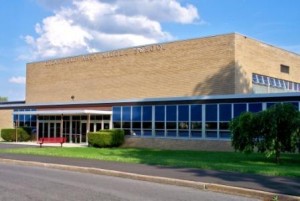
CLEARFIELD – Mathematics teachers supported the implementation of the new Chicago Math curriculum at the Clearfield Area High School and reassured the school board at its committee meetings Monday night that the students are committed and have progressed in the classroom.
Vice Principal Tim Janocko said he alongside Superintendent Dr. Thomas B. Otto and Director of Curriculum/Instruction Bruce Nicolls invited members of the math department to present Chicago Math and the effect it’s already had on the students to eliminate any misperceptions.
“We’re seeing more students engaged. They are actively learning. We’re not seeing any kids with their heads down or sleeping. I invite anyone who wants to, to come in and observe. I’ll sit in the classroom with them. It’s neat what’s going on,” Janocko said.
Teacher Mary Hindman said her department has worked collectively during its transition to Chicago Math, which forces students to become more accountable. She said the students have learned the importance of reviewing their text and vocabulary and are more engaged during class.
According to her, if students struggle in their “team huddles,” they break away from their groups and tackle the problems as a whole. And, the math teachers have devoted time before and after school and during plan periods to identify changes or reinforcement to instruction.
Geometry teacher Sean Zimmerman said Chicago Math makes the students really think and not with a calculator and requires more problem solving of them. He proceeded by presenting a lesson plan during the “perfect day” in his classroom.
He said Chicago Math is presented to the students, using the “I Do It, We Do It, You Do It,” instructional model. First, he presents the lesson and outlines in detail its vocabulary, theorems, postulates, etc., which is followed with sample problems.
According to him, the class works through the sample problems, and once everyone understands, they break into their “team huddles,” and move into the “We Do It” phase. Each team is presented with two or three problems, and the students work collaboratively toward their solutions.
Zimmerman said after breaking from the groups, the class reviews the problems as a whole. Students move into the “You Do It” stage at this point and must solve two or three additional problems individually before returning to their groups to compare answers.
“That’s if it’s a perfect day,” he said.
If it’s not, additional time is allowed for student questions until they’ve fully comprehended a concept. Sometimes, he may work with a group of struggling students, while the rest are in “team huddles.” But he emphasized that math problems are reviewed plenty with the students.
When wrapping up the lesson, students are engaged again. He poses questions, which aren’t just “yes or no” or “pick A, B, C or D;” instead, he said “they have to think and engage.”
And, Zimmerman described his students’ engagement as “almost amazing.” In most math classes, according to him, students usually have their heads down and simply copy notes, while two or three participate and answer questions.
He said on a “slow day,” he has six or seven kids who participate and feel comfortable giving answers.
Board member Mary Anne Jackson said parents were complaining about the students’ homework not being checked. Zimmerman said in his class, their homework is reviewed by the students in class and placed in a folder. It’s returned the next day after he’s checked it.
However, Zimmerman pointed out that not all homework is a “graded assessment.” He assured though that the students are given and know the correct answers to their homework problems.
Jackson said parents had also expressed concern about their children who were “very good students” and who had received grades in the 30s. Zimmerman said he couldn’t speak for everyone, but his students’ grades were initially low but improved with time.
Board member Jennifer Wallace then asked about the confidence level of students. Zimmerman said they’re opening up and asking more questions, and because they’re engaged more, they feel more comfortable asking questions before the class with no one being singled out.
Hindman explained that the Chicago Math program involves a lot of reading, which has been part of the battle. She said they look for ways to give students “partial credit,” and the teachers are working to see what students are picking up and where they need more preparation before an assessment.
Principal Kevin Wallace said if a student struggles in reading, they’re going to struggle with the Chicago Math. He said they’ve emphasized to all teachers the importance of teaching reading, not just in English classes, but also in their respective subject areas.
“I love the groups. I love the team huddles . . . I’m finding it’s increasing the student responsibility. They’re learning the system,” teacher Judi Bookhamer said.
Janocko added, “The bar has been raised. The whole school is talking about math. It’s happening.”